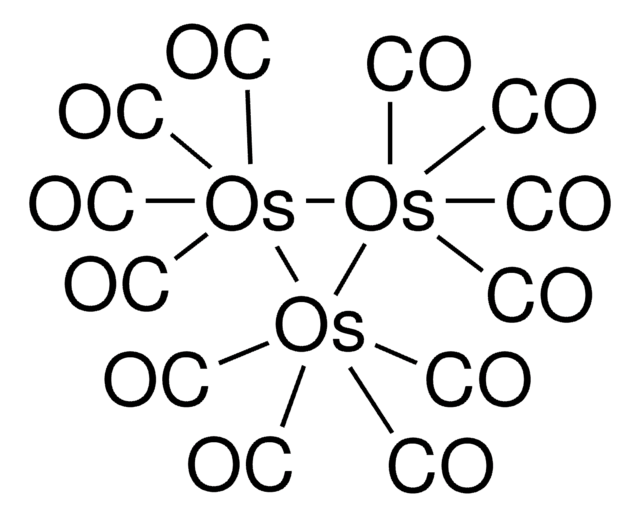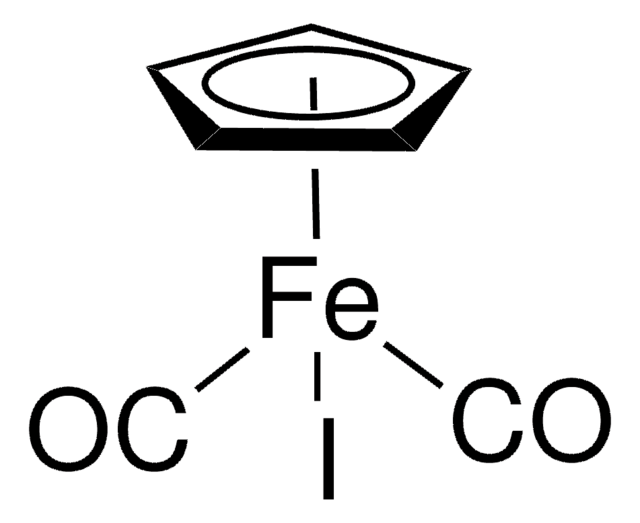60811
Kobaltcarbonyl
moistened with hexane (hexane 1-10%), ≥90% (Co)
Synonym(e):
Di-μ-Carbonylhexacarbonyldikobalt, Kobalttetracarbonyldimer, Octacarbonyldikobalt, Dicobalt-octacarbonyl
About This Item
Empfohlene Produkte
Assay
≥90% (Co)
Form
solid
Qualität
moistened with hexane (hexane 1-10%)
Eignung der Reaktion
core: cobalt
reagent type: catalyst
Lagertemp.
2-8°C
SMILES String
[Co++].[Co++].[C-]#[O+].[C-]#[O+].[C-]#[O+].[C-]#[O+].[C-]#[O+].[C-]#[O+].[C-]#[O+].[C-]#[O+]
InChI
1S/8CO.2Co/c8*1-2;;/q;;;;;;;;2*+2
InChIKey
MQIKJSYMMJWAMP-UHFFFAOYSA-N
Suchen Sie nach ähnlichen Produkten? Aufrufen Leitfaden zum Produktvergleich
Anwendung
- Kobaltcarbonyl [Co2(CO)8] wird häufig als Katalysator in der Hydroformylierung (Oxosynthese) von Alkenen verwendet.
- Zusammen mit Pyridin kann es als Katalysator in der Carboxylierung von Alkenen in entsprechende Säuren und Ester verwendet werden.
- Es wird als Hauptvorläufer in der Herstellung von Nanokristallen aus Cobaltplatin (CoPt3), Cobaltsulfid (Co3S4) und Cobaltselenid (CoSe2) verwendet.
- Es kann auch als Reagenz in Pauson-Khand-Zyklisierungen und in Nicholas-Reaktionen eingesetzt werden.
Signalwort
Danger
Gefahreneinstufungen
Acute Tox. 1 Inhalation - Acute Tox. 4 Oral - Aquatic Chronic 3 - Carc. 2 - Repr. 2 - Self-heat. 1 - Skin Irrit. 2 - Skin Sens. 1 - STOT RE 2 Inhalation
Zielorgane
Nervous system
Lagerklassenschlüssel
4.2 - Pyrophoric and self-heating hazardous materials
WGK
WGK 3
Flammpunkt (°F)
-9.4 °F
Flammpunkt (°C)
-23 °C
Persönliche Schutzausrüstung
Eyeshields, Faceshields, Gloves, type P3 (EN 143) respirator cartridges
Analysenzertifikate (COA)
Suchen Sie nach Analysenzertifikate (COA), indem Sie die Lot-/Chargennummer des Produkts eingeben. Lot- und Chargennummern sind auf dem Produktetikett hinter den Wörtern ‘Lot’ oder ‘Batch’ (Lot oder Charge) zu finden.
Besitzen Sie dieses Produkt bereits?
In der Dokumentenbibliothek finden Sie die Dokumentation zu den Produkten, die Sie kürzlich erworben haben.
Kunden haben sich ebenfalls angesehen
Artikel
Magnetic nanoparticles have attracted tremendous attention due to their novel properties and their potential applications in magnetic recording, magnetic energy storage and biomedicine.
Ultrasonic spray pyrolysis produces scalable nanomaterials like metal oxides and quantum dots for diverse applications.
Unser Team von Wissenschaftlern verfügt über Erfahrung in allen Forschungsbereichen einschließlich Life Science, Materialwissenschaften, chemischer Synthese, Chromatographie, Analytik und vielen mehr..
Setzen Sie sich mit dem technischen Dienst in Verbindung.











